What are Leca clay balls? What is Leca and why is it a good substrate for your plants? Or is it a good choice for you? Here are some Pros and Cons of Leca clay balls.
What Is Leca?
Leca is an acronym for Light weight Expanded Clay Aggregate. Natural clay is heated to extremely high temperatures in kilns. The process results in these unique round absorbent clay pebbles of various sizes. The kiln process results in baked clay balls that are porous and VERY airy and lightweight.
LECA clay pebbles have a round shape that won’t compress or crush plant roots. It is easy for plant roots to grow through the clay balls while sipping the hydroponics fertilizer captured in the clay pebbles.
The balls of clay wick up water and hydroponics fertilizer. They are released as feeding plant roots travel through the clay balls and absorb what they need. The excess water and nutrients are stored in a water reservoir under the pot containing the plant and clay pebbles.
This type of set up is designed for indoor plants in a passive hydroponic gardening system. The system is simple to set up with the proper pot. There is no water flow from a pump. This wicking process allows plant roots to sip only the liquid nutrients they need to thrive directly from the saturated clay balls.
The clay pebbles come in various size clay balls or pebbles. This allows you to control the amount of air to your roots. The larger the balls, the more air for your roots.
The Hydroton Leca I use has a mix of randomly sized clay pebbles in the bag. If you shop on Etsy you will find some stores offer Leca in batches sorted by size.
Leca balls for plants is most often used as a complete soil replacement. Although you can mix with soil to increase aeration to whatever degree you wish, or place LECA under the soil to aid in drainage.
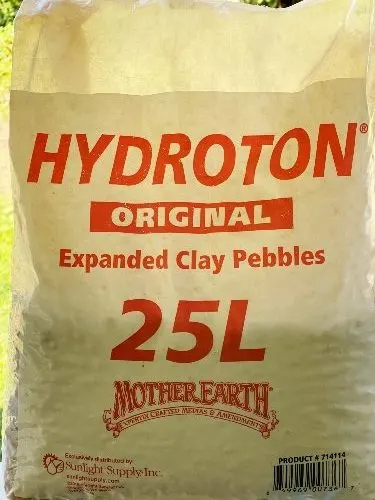
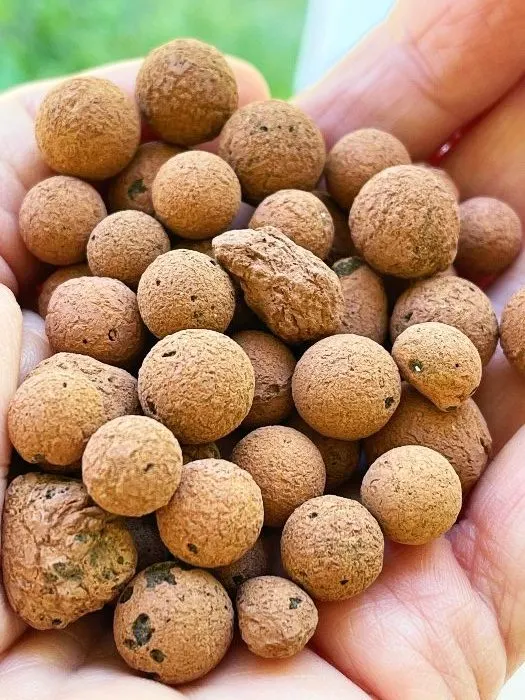
How Does LECA Keep Plants Watered?
Indoor plants in soil with heavy organic matter often struggle with excess water smothering roots from frequent watering. Over watering often causes root rot and encourages pests in the soil like fungus gnats.
Here’s how Plants access water from LECA clay pebbles :
- When thoroughly rinsed and soaked Leca clay balls absorb water using capillary action until they are full.
- When a plant is set into a pot full of fully hydrated LECA balls the roots will wick away the water in and on the clay pebbles.
- As the LECA balls lose moisture they draw more up (with the nutrients) from the reservior in the bottom of the pot.
- Leca balls of clay allow the plant to suck up only the moisture it needs, rather than accepting more moisture to its roots than is best for the plant.
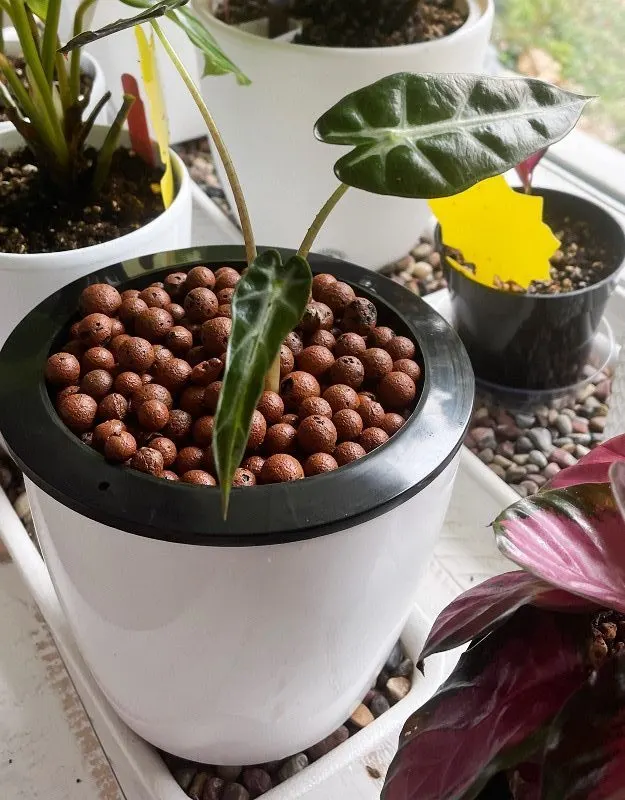
Leca Pros:
Leca is a good medium for plants. It promotes healthy plant growth for your house plants with a range of benefits indoor plant enthusiasts will enjoy.
- Almost all houseplants can grow successfully in LECA. Types of plants that have happy plant roots in LECA include Spider Plant, Snake plants, Orchids, Monstera, Philodendron, Alocasias, and pothos are a few good choices for LECA. Click the link for the plant guide for each of these plants.
- Hydroponic systems often are difficult to set up and require a constant flow of water to the plant. The LECA ball system is quite simple to set up and maintain. The Clay balls provide air pockets that prevent lack of oxygen to the plant roots.
- This passive semi hydroponic growing system REALLY helps with plant maintenance chores. The LECA system reduces frequent watering. The pot will go 2 weeks or so before you have to feed it more nutrient solution.
- Overwatering, yellow plant leaves and root rot a problem for you? This growing method may be your answer. The plant drinks what it needs and the rest of the water stays in the bottom of the pot away from the roots. No more excess water around the roots of plants.
- Pest free indoor plants is a much closer goal for plants grown in Leca. It has no soil so the clay pellets cannot support or attract fungus gnats, aphids and other soil borne pests.
- Clay balls are cleaner than soil to handle. Although those little balls can spill easily and roll a long way quickly! 🙂
- Using hydroponic fertilizer properly adjusted to your individual plants ensures your plant root systems are getting fed a very good diet of liquid fertilizer.
- LECA Balls can be reused once through a cleaning process. Clay balls do not lose nutrients, since they have none and do not break down. Just wash, boil and reuse as needed.
Leca Cons:
- You do have to invest in the proper supplies. This can be pricey initially. You will need LECA, Leca system plant Pots (or make your own) and hydroponic nutrients.
- LECA clay balls will need to be cleaned of clay dust before use. Rinse off the balls and put them in a pot of water to boil before using them as a medium for plants.
- LECA has NO nutrients to support the plant, like soil does. You must use a hydroponic fertilizer with this growing system. The semi hydroponic nutrients are not like your normal plant fertilizer. A general purpose plant fertilizer will not provide EVERY nutrient your plant needs since they are designed to work with soils. Hydroponic fertilizer are the only reasonable plant food options for LECA growing methods. If you buy the one I use it allows you to adjust the mix minutely to suit every plant. Of course, this means you have to learn the proper mixes for your plants to get it perfect. I just followed the basic instructions.
- Transitioning soil potted plants to LECA can be tricky. I have killed several plants that were growing we’ll in soil and could not make the change over to LECA. It is usually much easier to take a water cutting with roots and plant it in LECA. All plants grown in LECA must grow water roots to feed in semi hydroponics.
- Plants in soil must be prepared for growing in LECA. Remove all the soil off the roots and thoroughly wash them to eliminate the soil. This is stressful to the plant but necessary.
- LECA is naturally high in minerals and PH. Some plants will not like the high PH of clay balls. LECA must be properly prepared or your tropical plants will not be happy.
Read Our Posts on which Plants grow best in LECA, Best Leca Plant pots, and how to prepare and maintain a plant in LECA.
Watch Kayti Convert a water propagation pothos AND a soil potted Monsera Adonsoni.
Where to buy LECA and LECA Supplies:
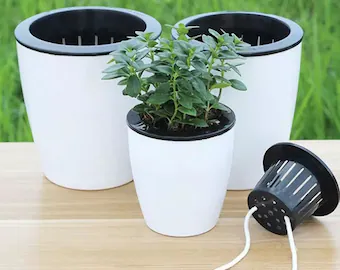
You can look at your local garden shop for LECA supplies. But they are rare on the shelves in my local shops.
Follow this link to Purchase Leca Pots from Amazon. They have a good selection of LECA and supplies at decent prices. But Amazon delivery is currently not that reliable, I’m sorry to say. Hopefully it will get better with time.
Leca Pots and Supplies are also available on Etsy. Etsy shops have a LOT of supplies and options for leca, leca compatible pots, and the proper fertilizers for semi hydroponics.
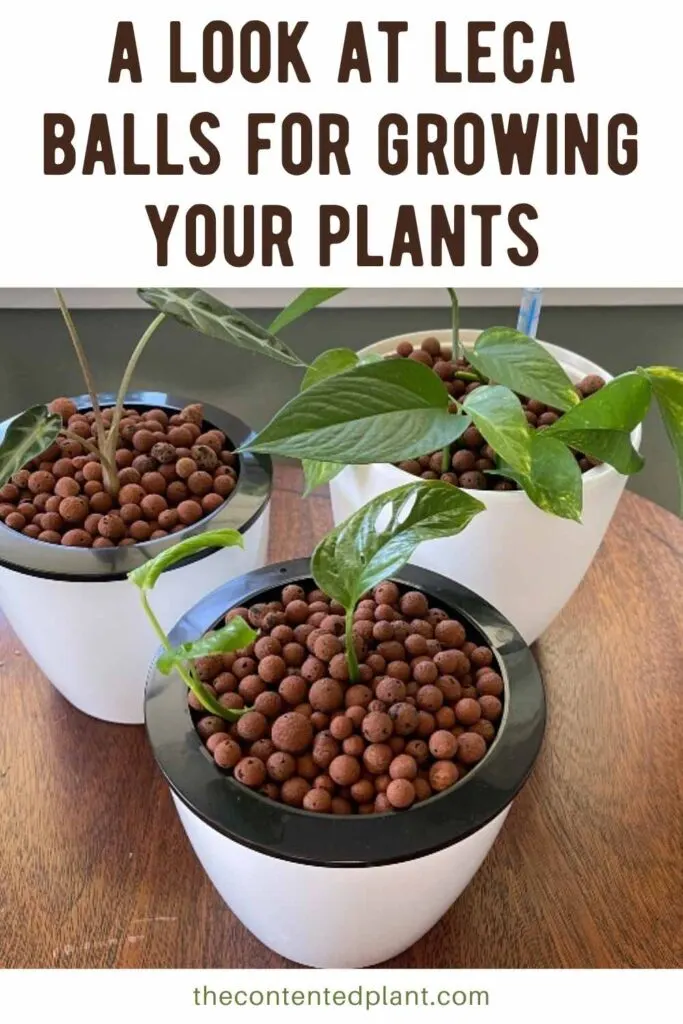
Follow Us:
Find us on YouTube, Instagram , Pinterest and TikTok! We love to Plant chat. We also comment, like and occasionally share your content to our daily stories. We’d love to see your plants. Share your joy in your houseplants. Happy Planting!
Recent Posts:
For Further reading on LECA check out the LECA Addict

Parodia leninghausii - The Contented Plant
Wednesday 5th of July 2023
[…] Growing in Leca Balls-Pros and Cons […]
Bottom Watering Plants in Pots: - The Contented Plant
Friday 21st of January 2022
[…] Growing in Leca Balls-Pros and Cons […]
Leca For Plants- Which Plants Thrive in LECA? - The Contented Plant
Thursday 9th of September 2021
[…] Learn what LECA is and how it works in this post. Growing in LECA […]